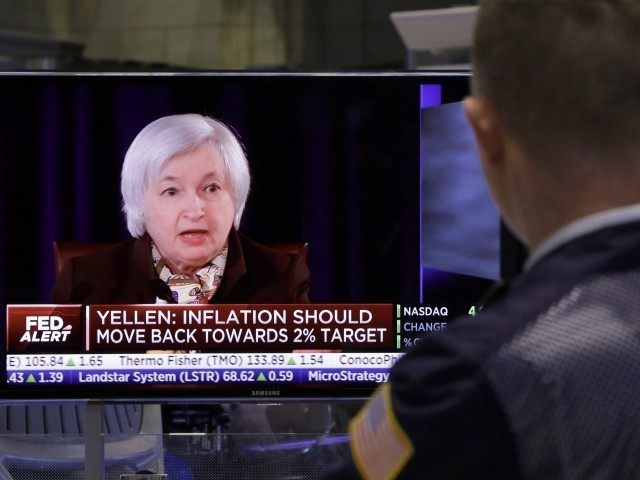Investors anxiously await Federal Open Market Committee (FOMC) minutes, like the details of the April 28-29 meeting released Friday. But despite the Fed’s monetary policy purchase of $4 trillion in bonds to drive interest rates to near zero, Fed Chairman Janet Yellen just admitted that consumer demand is so low that American wages have only risen by 2 percent over seven years.
James Montier has argued in a new paper that the Fed’s monetary policy cannot drive consumer demand. Coupled with President Barack Obama’s huge 2010 tax increases, he says, U.S. poverty rose and 876,000 jobs were lost.
The Treasury’s balance at the Federal Reserve has begun to decline from the all-time-record levels reached in early May as tax payments due on April 15 continued to be processed. The government is now spending the massive tax windfall from Obama’s huge tax rate increase passed in 2010. The ;eft promised that this high tax “fiscal policy” drag on the economy would be more than offset by the Federal Reserve’s ultra-low interest rate “monetary policy.”
On Friday, Fed Chair Yellen said that while the official unemployment rate of 5.4% and approaching what many Federal Reserve officials consider to be consistent with “full employment,” the jobless rate “probably does not fully capture the extent of slack in the labor market.” She stated that “the labor market has not fully healed,” since big U.S. companies only raised wages by 2 percent during the improving economy.
Montier, a member of the asset allocation team at GMO, argues that investors have become too obsessed with monetary policy. “There is precious little evidence that monetary policy matters for the major components of demand (investment and consumption look pretty immune to the shifts in interest rates over time). Perhaps it is time to recall that we have another tool in our economic kit: fiscal policy,” he writes.
Montier is skeptical of the government central planners’ “New Keynesian” views, which dominated the Fed’s policy following the 2008 Great Financial Crisis (GFC). Key to this effort was the embrace of the Fed setting what it referred to as an “equilibrium real interest rate.” But Montier doesn’t believe such a thing exists, and even if it did, he argues, there would not be a “channel” to meaningfully affect aggregate demand.
The New Keynesians believe that lower interest rates will make corporations more likely to invest in building new plants and purchasing new equipment, since they are easier to finance. But “most corporations use internal financing for the vast majority of their work, as they have for decades. It’s true that bonds have become more popular since the end of the financial crisis, but internal financing is still contributes over 100% of gross corporate financing, according to the ‘Flow of Funds’ data,” he argues.
Montier says that it can be argued that pulling down the Fed’s discount rate makes more projects become profitable, but corporate management surveys have repeatedly shown that companies use a hurdle rate of 15 percent profitable return to decide if investments in new projects make business sense, regardless of what the interest rate cost of borrowing in the bond market.
There also is “no discernible relationship between real interest rates and US household savings either,” he says. Reducing interest rates does not induce people to increase their consumption in a meaningful way. Lower rates may encourage more young people to engage in car-buying, because the payment is lower. But seniors who tend to live off their savings will cut back spending as their income falls. There is no net spending increase.
Montier does believe that monetary policy can create a “Wealth Effect,” as investors in bonds and stock see the value of their portfolios jump. But people who own investment real estate, stocks and bonds tend to be well off and have a low “marginal propensity” to increase their consumption.
The President and his liberal supporters passed a tax increase that they said would only hurt upper-income taxpayers and businesses. But at the time, Center for Data Analysis (CDA) economists estimated that since the tax hit heaviest on small businesses, the primary job creators in the country, the net effect of the Obama tax would reduce inflation-adjusted economic growth by $100 billion per year and cost 876,000 jobs.
Six years later, CDA’s estimates are eerily on target, with the current recovery being the worst since the Great Depression. The total number of jobs has grown by only 6.5 percent during this recovery, versus 12.9 percent average in previous recoveries. Median inflation-adjusted household income fell from $56,436 to $51,939, while the poverty rate increased increased by 0.2 percentage points during this recovery, versus a decline of 0.7 percentage points in previous comparable recessions.

COMMENTS
Please let us know if you're having issues with commenting.